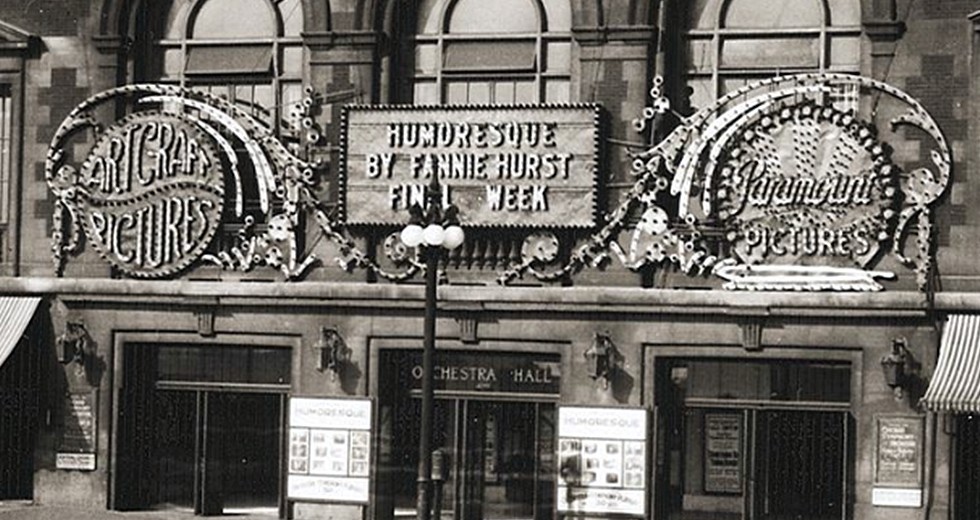
If you were intrigued by the CSO social media post about the silent film “Humoresque” (1920), which was screened at Orchestra Hall that summer, here’s more of the backstory behind the photo:
Regarded as the “first great Jewish-themed movie,” “Humoresque” is notable for several reasons. Set in the world of classical music, it follows a Jewish boy from the New York City slums who becomes a violin prodigy and then uses his career to climb the social ladder. (In 1947, it was remade with Joan Crawford and John Garfield, and more was made of the Dvořák violin transcription that inspired the film’s title.) Fannie Hurst wrote the short story that inspired the movie; it had been published in the March 1919 edition of Cosmopolitan (which was a general interest magazine before Helen Gurley Brown turned it into a lifestyles/sex/fashion monthly in the 1960s).
Cosmopolitan also was the name of the production company, headed by media magnate William Randolph Hearst (the inspiration for “Citizen Kane” [1941]), behind “Humoresque.” The film’s screenplay was co-written by William LeBaron, an Elgin native and University of Chicago alum, who went on to produce more than 230 films, and Frances Marion, a pioneering scribe who opened doors for female writers, directors and behind-the-scenes talent in early Hollywood.
Despite its notable origins, “Humoresque” almost was shelved. Paramount Pictures president Adolph Zukor, one of the many Jewish moguls who established the production studios of early Hollywood, objected to the film. “If you want to show Jews,” he told Frances Marion, “show Rothschilds, banks and beautiful things. It hurts us Jews — we don’t all live in poor houses.”
So the film was relegated to Paramount’s Artcraft subsidiary and released to what was expected to become obscurity. Instead, it turned into a box-office bonanza, playing for weeks after its initial release in May 1920. In its review, Picture Play magazine wrote, “Never before has such a perfect atmosphere of reality been communicated to the screen. Any fine work of art must have the power of drawing the spectator into its very center. This, ‘Humoresque’ accomplished. The life of the Jewish family is your life while you sit and watch the screen. It will live for years and will be held up as a standard for aspiring artists to aim at.”
But perhaps the film’s greatest claim to fame is its now-forgotten co-star Alma Rubens, a tragic figure who died at age 33 from the effects of heroin addiction. Months before her death, she gave interviews for a newspaper serial titled “Why I Remain a Dope Fiend: The Most Amazing Confession Ever Told! Alma Rubens’ Own Story.”
How Rubens went from a San Francisco covent-school upbringing to silent-film stardom to drug addiction is worthy of its own movie. One of her earliest roles set the tone for her life of dissolution: “The Mystery of the Leaping Fish” (1916), a drug-fueled comedy starring Douglas Fairbanks Sr. as a Sherlock Holmes-like detective named Coke Ennyday, who wears a bandolier of syringes and possesses a large container marked COCAINE.
It’s unclear how Rubens got hooked on narcotics. Some accounts claim she was burned in an accident; others report that doctors prescribed drugs, which she then abused, to lift her mood. By the late ’20s, her career had derailed. Her third husband, actor Ricardo Cortez, and her mother had her committed to a state institution to treat her narcotics abuse. After a few more roles, in “Show Boat” (as the tragic Julie) and “She Goes to War,” her film days were over.
Desperate for money, she agreed to the newspaper serialization, which had been arranged by her friend, actress Marion Davies (and longtime Hearst mistress). In January, 1931, suffering from pneumonia, Rubens died, just two months before her 34th birthday.
In an obituary, the Los Angeles Times called the actress the “queen of emotional actresses.” Indeed, that was her speciality. “From her first featured role with Fairbanks in ‘The Half Breed’ (1916) to her final role in ‘Show Boat’ (1929), Rubens specialized in portraying women under great emotional stress,” notes the site Obscure Hollywood. “The public and the critics were moved by the power of her acting.”
Her serialized memoirs were republished as Alma Rubens, Silent Snowbird: Her Complete 1930 Memoir, with a New Biography and Filmography by McFarland & Co. in 2006.

